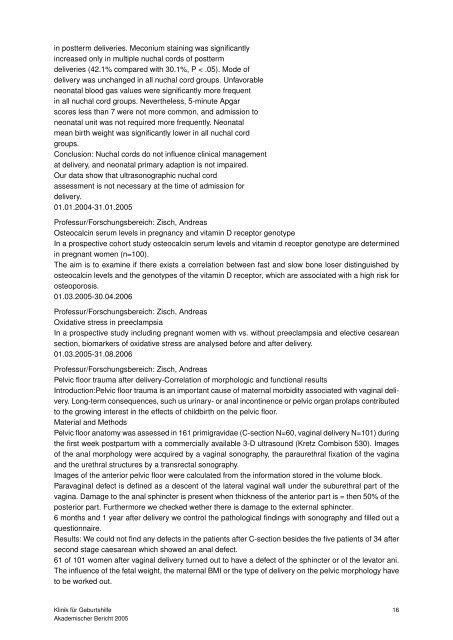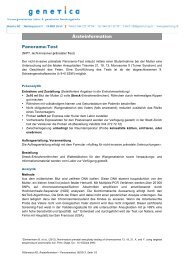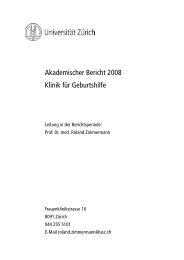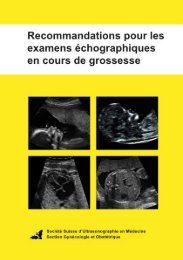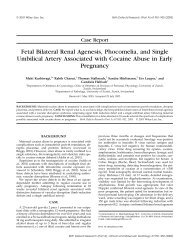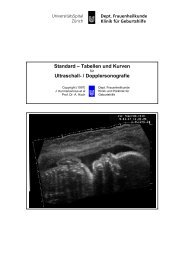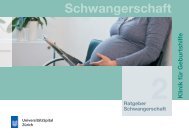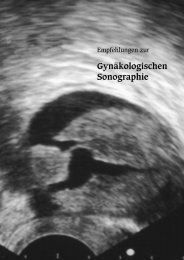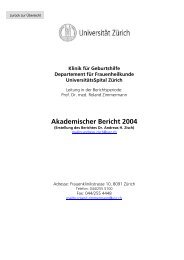Akademischer Bericht 2005 - Geburtshilfe - UniversitätsSpital Zürich
Akademischer Bericht 2005 - Geburtshilfe - UniversitätsSpital Zürich
Akademischer Bericht 2005 - Geburtshilfe - UniversitätsSpital Zürich
Erfolgreiche ePaper selbst erstellen
Machen Sie aus Ihren PDF Publikationen ein blätterbares Flipbook mit unserer einzigartigen Google optimierten e-Paper Software.
in postterm deliveries. Meconium staining was significantly<br />
increased only in multiple nuchal cords of postterm<br />
deliveries (42.1% compared with 30.1%, P < .05). Mode of<br />
delivery was unchanged in all nuchal cord groups. Unfavorable<br />
neonatal blood gas values were significantly more frequent<br />
in all nuchal cord groups. Nevertheless, 5-minute Apgar<br />
scores less than 7 were not more common, and admission to<br />
neonatal unit was not required more frequently. Neonatal<br />
mean birth weight was significantly lower in all nuchal cord<br />
groups.<br />
Conclusion: Nuchal cords do not influence clinical management<br />
at delivery, and neonatal primary adaption is not impaired.<br />
Our data show that ultrasonographic nuchal cord<br />
assessment is not necessary at the time of admission for<br />
delivery.<br />
01.01.2004-31.01.<strong>2005</strong><br />
Professur/Forschungsbereich: Zisch, Andreas<br />
Osteocalcin serum levels in pregnancy and vitamin D receptor genotype<br />
In a prospective cohort study osteocalcin serum levels and vitamin d receptor genotype are determined<br />
in pregnant women (n=100).<br />
The aim is to examine if there exists a correlation between fast and slow bone loser distinguished by<br />
osteocalcin levels and the genotypes of the vitamin D receptor, which are associated with a high risk for<br />
osteoporosis.<br />
01.03.<strong>2005</strong>-30.04.2006<br />
Professur/Forschungsbereich: Zisch, Andreas<br />
Oxidative stress in preeclampsia<br />
In a prospective study including pregnant women with vs. without preeclampsia and elective cesarean<br />
section, biomarkers of oxidative stress are analysed before and after delivery.<br />
01.03.<strong>2005</strong>-31.08.2006<br />
Professur/Forschungsbereich: Zisch, Andreas<br />
Pelvic floor trauma after delivery-Correlation of morphologic and functional results<br />
Introduction:Pelvic floor trauma is an important cause of maternal morbidity associated with vaginal delivery.<br />
Long-term consequences, such us urinary- or anal incontinence or pelvic organ prolaps contributed<br />
to the growing interest in the effects of childbirth on the pelvic floor.<br />
Material and Methods<br />
Pelvic floor anatomy was assessed in 161 primigravidae (C-section N=60, vaginal delivery N=101) during<br />
the first week postpartum with a commercially available 3-D ultrasound (Kretz Combison 530). Images<br />
of the anal morphology were acquired by a vaginal sonography, the paraurethral fixation of the vagina<br />
and the urethral structures by a transrectal sonography.<br />
Images of the anterior pelvic floor were calculated from the information stored in the volume block.<br />
Paravaginal defect is defined as a descent of the lateral vaginal wall under the suburethral part of the<br />
vagina. Damage to the anal sphincter is present when thickness of the anterior part is = then 50% of the<br />
posterior part. Furthermore we checked wether there is damage to the external sphincter.<br />
6 months and 1 year after delivery we control the pathological findings with sonography and filled out a<br />
questionnaire.<br />
Results: We could not find any defects in the patients after C-section besides the five patients of 34 after<br />
second stage caesarean which showed an anal defect.<br />
61 of 101 women after vaginal delivery turned out to have a defect of the sphincter or of the levator ani.<br />
The influence of the fetal weight, the maternal BMI or the type of delivery on the pelvic morphology have<br />
to be worked out.<br />
Klinik für <strong>Geburtshilfe</strong><br />
<strong>Akademischer</strong> <strong>Bericht</strong> <strong>2005</strong><br />
16


